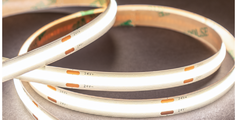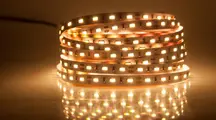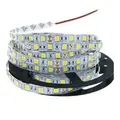LED light strip types: Part 2
According to input voltage
Light strips are made up of many lamp beads of the same specifications, spliced together with different numbers of series and parallels. Then, different series and parallel numbers, as well as circuit schemes, will allow the light strips to have different input voltages.
Mainly divided into the following categories:
High voltage 220V
High-voltage light strips are common daily light strips. They are generally in the form of a very long bundle, ranging from 50 to 100 meters. They are basically fully filled with glue and can be cut by the meter at will (now there are 100mm ones) High-voltage light strip), with a power head and a tail cover, connected to the mains, it can be used normally.
High-voltage light strips consist of wires on both sides and a flexible light panel in the middle. High-voltage light strips are used to transmit high-voltage electricity; and the flexible light panels of each unit are strung together in a certain number, using resistors to limit the current, and then spliced to the wires on both sides.
There is a small protrusion on the power supply head, which is actually a bridge stack, a device used to convert AC high-voltage power into DC power. Generally speaking, the rated current setting of the bridge stack cannot be exceeded, otherwise it will easily burn out.
The benefits of high-voltage light strips are:
One power supply can be up to 50-100 meters long.
Equipped with a power plug, it can be directly connected to the mains power.
Although most of them can only be cut to full meters, they are enough.
These features are exactly what electricians and installers like. It has simple composition and easy installation. However, there are many shortcomings.
The disadvantages are:
When cutting the whole meter, some parts that need to be cut accurately are either not long enough, or folded for use, resulting in uneven brightness and the risk of burnout.
Although the wiring is convenient, because it is directly connected to the mains power, there is no driver protection. Therefore, some surge current, peak voltage and other grid pollution will be directly conducted to the light strip, which can easily cause the light strip to burn out.
Quality varies, and it's very easy to buy low-quality high-voltage light strips. For example: thin flexible plates, low-brightness lamp beads, iron or aluminum wires.
Low voltage constant voltage light strip
Low voltage, compared to high voltage, is generally powered by DC. The voltages are as follows: 5V, 12V, 24V, 36V, and 48V.
Constant voltage means that a transformer with a constant voltage output is required to provide stable voltage DC power to the light strip.
The principle of the light strip is that the lamp beads are generally connected in series with the resistor, and the voltage at both ends is exactly the set constant voltage input voltage. The purpose of resistors is generally to limit current. There are also those that directly use constant current transistors or constant current ICs. Then splice them all into the main positive and negative poles.
Low-voltage light strips generally range from 33mm to 100mm in one cutting unit.
Low voltage constant current light strip
For low voltage, the input voltage is generally set between 22-40V.
Constant current means that a constant current driver is required to provide a stable current of DC power to the light strip.
The principle of the light strip is generally to string the lamp beads directly without resistors, transistors or ICs, and then connect them to the main positive and negative electrodes. The voltage of each section of the lamp strip is basically the same, but the total current needs to be set according to the rated current of the lamp bead, heat dissipation conditions, etc.
Low voltage constant current lamps have many advantages:
There are no resistors, transistors, diodes, etc., so the luminous efficiency is high. This means that with the same power and the same lamp beads, a constant current light strip will be brighter than a constant voltage light strip.
The voltage is often higher, and the constant current is generally set between 30-36VDC; and the commonly used low-voltage constant voltage light strips are generally 12VDC, so the voltage drop on the light strips will be higher than the constant voltage 12VDC light strips. Less, the brightness is more uniform at the head and tail.
The power, brightness, and even control of the light strip are all adjustable and can be achieved by matching different constant current drivers. The constant voltage light strip basically cannot change.
The only difficulty in using constant current light strips compared to constant voltage light strips is that you need to be familiar with LED drivers, which are readily available.
By light color
Light colors include color temperature system, color system, and change system
Color temperature system
When installing the blackbody color temperature, we associate the correlated color temperature measured by the LED to the blackbody color temperature, so the LED is generally called correlated color temperature. It is generally produced by a blue light chip that emits light and is made of phosphors in different proportions.
Below 2000K, red and yellow, like the color of the sun when it sets
2200-2700K, golden yellow, color temperature is orange-yellow
2800-3500K, generally 3000K, called warm light (also called warm white light)
3500-4200K, based on 4000K, is called natural light. (Some people also call this warm white light)
4500-5500K, white light, suitable for office, reading, etc. However, there are not many choices for lamp beads in this color temperature range.
5800-6800K, cool white light, white light in the general sense, is in this color temperature range, and the benchmark is 6500K.
7000-8000K is cooler than 6500K and has a bluish feel. This color temperature is generally not needed for home use. However, some special scenes, such as jewelry lamps, need to be used.
Above 9000K, it is already in the range of blue to purple, and the ultraviolet part falls into two segments: UVA and UVB. Belongs to special use scenarios, such as aquarium, mosquito trap, ultraviolet disinfection, etc.
Color system
Colored light in the general sense is emitted by an LED chip holder that directly emits light of this color.
Commonly used colors are: red, yellow (different from warm white yellow), blue, green, purple, ice blue, pink, amber, etc.
system of change
It is a light strip that can emit multiple colors of light at the same time.
Half of them are:
RGB is what we often call colorful light strips
RGBW is RGB plus a color temperature color, such as: RGB+3000K, RGB+6500K
RGBWW is RGB plus two color temperatures, such as: RGB+3000K+6500K.
By the way, when the color temperature of 3000K and 6500K are lit at the same time, through light mixing, a color temperature of 4000K can be produced.
According to the control method of the light strip
The most common one is the on/off state, which lights up when the power is connected and goes off when not connected.
ON/OFF
That is, single color temperature on/off;
If there are dual color temperatures on the light strip, you can have dual color temperatures on/off;
Dimming and color matching
Through the on/off of single and double color temperatures, we can also control dimming and color temperature through thyristor, 0/1-10V, DALI, Bluetooth, zigbee, 2.4G and other control methods.
RGB colorful
Next, there is the colorful control of RGB, usually a 4-wire RGB light strip, which can perform slow changing, fast changing, jumping and other effects of 7 colors at the same time, usually through a preset controller.
DPI serial signal
RGB Symphony DPI series signal control, usually a 3-wire light strip, and all are IC addressable, which can achieve gradient effects such as horse racing and chasing. Can be set and controlled via DPI controller.
DMX512 signal
DMX512 control uses the DMZX512 protocol to perform addressable control of the light strips. Generally, it is a 5-wire light strip, with 2 wires for power supply and 3 wires for control.
Human body induction
Use infrared or radar probes for human body sensing. If someone moves, the lights will turn on for 40-50 seconds. If there are still people moving during this period, the time will be accumulated. If no movement is detected, the lights will turn off after 40-50 seconds. This function is very practical, can save energy, and is relatively smart.
Hand scan sensor
Within 5cm of the sensor probe, you can control the switch of the light strip by sweeping it with your hand. This is generally used on cabinet lights. When you hold a pot and spatula in both hands, sweeping becomes very practical.
Door feel
Similar to the hand scan sensor, the sensor head will detect whether there are obstacles within a distance of 3-5cm. If there are obstacles, the lights will be turned off; if there are no obstacles, the lights will be on. This is commonly used in wardrobes, cabinets, or other places with doors. The lights turn on when the door is opened and automatically turn off when the door is closed, which is smart and energy-saving. It will make you unable to put it down.
According to material shape
This classification may be a bit repetitive, so I won’t go into details. It generally includes some special forms of light strips;
like:
S type

S-shaped bare board light strip, because the base plate is installed in an S-shape, it can be moderately bent in the horizontal direction.
Hard light strip

Install the light strip on the aluminum profile and use it with different aluminum profiles to use it on shelves, wardrobes, baseboards, ceiling lines, etc.
Single sided light

Generally speaking, light strips emit light from one side and emit light in two directions: front light and side light. The main difference is the construction of the silicone sleeve.
Double-sided light

In some special applications, the substrate has lamp beads on the upper and lower sides, so it can emit light from both sides.
360° full illumination

Using a round silicone sleeve and a top and bottom light strip, you can create a 360° fully illuminated light strip.





